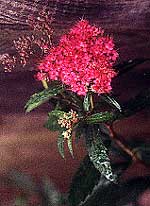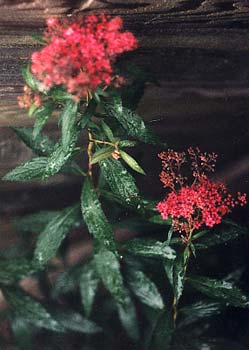
Bumalda Japanese Spirea
"Love blooms like a tardy flower
Here in the day's after-glow."
-Hart Crane
(1899-1932)
(1899-1932)
Spirea is no chore. You plant it, it grows, it blossoms swell. It can be made handsomer with annual pruning, & it will be more densely leafed & healthier with regular watering, but even if neglected it'll flourish.
 This one is a Japanese Spirea. Its blossoms occur as flat-topped corymbs in a rich shade of rosy pink or deep purple. Ours has had its share of abuse because it was twice transplanted in three years, & hard-pruned before the second move, but each time it came right back.
This one is a Japanese Spirea. Its blossoms occur as flat-topped corymbs in a rich shade of rosy pink or deep purple. Ours has had its share of abuse because it was twice transplanted in three years, & hard-pruned before the second move, but each time it came right back.I don't ordinarily move plants once they're in the ground as I do give them a great deal of advance thought as to position. But I must admit I wasn't enjoying this spirea as much as I thought I would, & it got shuffled farther back in the garden.
My initial disappointment I can't fully explain, but I think I was hoping it would grow to be specimen-worthy if positioned to be a center of attention. In a mixed-background-border, it is much more successful, with a very long bloom period. It now seems to be in its permanent location partially obscured by a large Dawn Viburnum & 'Plum Blossom' Nandina. It would probably like to have more sun than it can get at the back of that garden, but spireas are hardy & adaptable, so this one's doing fine even with a bit more shade than is ideal. The summer flowers reaching out from behind the viburnum are very exciting to see, & it reblooms right through October. So I no longer have any sense that I made a mediocre choice in obtaining it, & by its beauty it has cured me of a transient prejudice.
Japanese spirea has been cultivated in America since the 1870s. It is native of Japan, Korea, & China, but has naturalized throughout much of the midwest & eastern United States, & in England. It produces thousands & thousands of seeds which float on streams & rivers, so that it was able spread along the banks of waterways far, far from where it was originally planted.
In a dryer sunnier spot the leaves turn bronzy purple in summer, but it will also be less leafy & more susceptible to mites. In a protected spot the leaves are dark green until autumn, then become a bright purplish bronze. These colorful leaves last long into autumn, as do the blooms which begin in June & are in full glory in July, recurring until first frost.
If left unpruned it goes rather rangy & can reach to six feet high, but looks best if kept more compact to around four feet. It will even benefit from occasional hard-pruning to keep it compact. It suckers quite a lot, & can be permitted to spread until it looks substantial, & thereafter new suckers should be removed. It may be tempting to just let it go wild, but it flowers primarily on new wood, & for maximam floral value does need annual pruning to encourage new wood. I'm essentially using this spirea as "fill" for an area between shrubs, the front shrubs requiring very little if any pruning. This allows some crowding for a densely planted appearance, but anytime the crowding begins to look a bit stressful to the main shrubs, trimming back the spirea restores airiness.
Hard-pruning can be in autumn or very early spring. In our temperate area it is actually semi-deciduous so it can be worth saving all of it through the winter & not cutting it back until it gets to looking too scruffy to any longer serve a decorative value for the winter garden.
Ours is almost certainly a hybrid cultivar, but was obtained unlabeled. The "Bumald" group of hybrids are crossed with S. albiflora & will be variously labeled S. japonica 'Bumalda' or S. x bumalda followed by a cultivar name. Most of these are at least a little smaller than the species shrub, but still potentially invasive. Of the cultivars I've compared ours to, ours except for being larger looks much like 'Anthony Waterer' for flower color & for bright purply-bronze autumn color. But many other cultivars also look very close so I'll have to settle for knowing it's some variety of S. japonica & not worry about which cultivar.